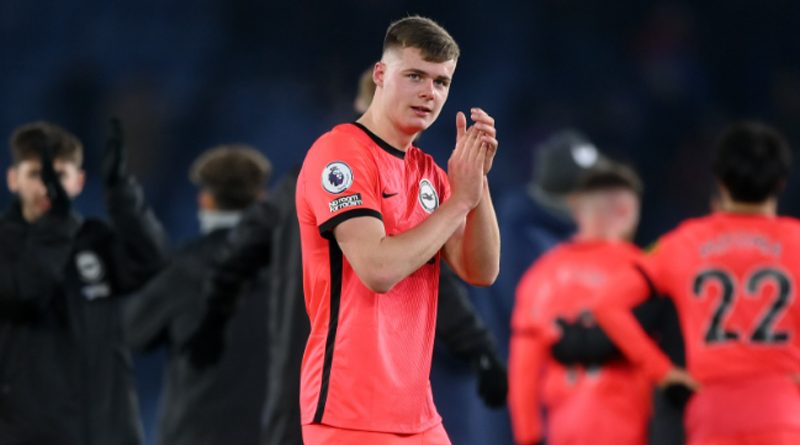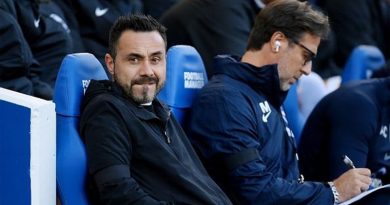How does the Brighton development model cope with Europe?
As the most successful season in Brighton & Hove Albion history comes to an end, the focus will move to the transfer window, who comes in and who leaves.
Whilst the main interest is inevitably on the ins and out outs of the first team squad, the decisions made will shine a significant light on an increasing conundrum faced by the club with its development system.
As supporters we love to claim “He’s one of our own”, taking extra pride in the performances of say Lewis Dunk and Solly March.
Alongside that, we have a club and manger very willing to put young players in the first team. The table below shows this, with 10 players aged 21 and under having appeared in the Premier League this season.
The key indicators therefore are still suggesting that all is working well with the Albion production line. However, the increasing level of performance as Brighton climb the table leaves the club with a major quandary going forward.
Amongst the many issues which Chelsea are regularly mocked over is the 30+ players they have out on loan most seasons, who then delivery stronger performances for their temporary club than those in the first team at Stamford Bridge.
Brighton are benefitting from this with Levi Colwill this season. Other examples include Conor Gallagher at Crystal Place last year and Fikayo Tomori when he joined AC Milan.
What was Chelsea’s logic in buying Benoit Badiashile, Kalidou Koulibaly and Wesley Fofana when they could have played Colwill?
As far back as 2016, the Bleacher Report headlined an article Chelsea’s Loan Policy Shows All That’s Wrong in Football’s Money-Driven World.
The management of loans can have an impact equally at the other end of the Premier League. How many more points might Southampton have earnt had they kept Nathan Tella rather than loan him to Burnley, where his 19 goals and 5 assists have been a significant part of the Claret’s promotion?
It sometimes goes unnoticed that Brighton sit second to Chelsea with 22 players having been loaned out during the current season.
Development loans are a well defined and often very successful part of the Brighton model. Moises Caicedo, Kaoru Mitoma and Robert Sanchez are amongst the current members of the first team squad to have benefited from such arrangements.
In contrast to Chelsea and Southampton, the development and contentment of those playing regularly out on loan elsewhere has not been outweighed by the potential use that Brighton might have made of individuals like Steven Alzate, Michal Karbownik and Andi Zeqiri when injuries have hit.
One issue that may affect future loan numbers is the FIFA directive designed to address player hoarding. From 1st July 2022, clubs have only have been allowed to loan out eight players aged over 21 during a season.
That number will go down to seven from July 2023 and to six from July 2024. The cap does not apply to homegrown players, who are classed as those who have been with either their current club or another in the same national association for at least three years between the ages of 15 and 21.
The young talent on the Albion’s books is equally evident in the list below, which shows an additional 15 players (excluding those already on the two previous lists) have played more than 400 minutes for a Brighton side sitting sixth in Premier League 2.
In both the loan list and the PL2 list, there are a significant number of players that appear capable of reaching Premier League standard.
One attraction of the Brighton job to Roberto De Zerbi was no doubt the pipeline of young players. De Zerbi would have done research, contrary to Graeme Souness‘ believe that the Italian just had a quick look on Google and knew nothing about the English game.
This pipeline is likely to remain a factor if or when De Zerbi considers future alternative job offers, say for example Spurs, were there is less talent ready and waiting to be called upon.
So all of the above appears positive so far. The challenge now is how to maintain that with the far higher standard of play required to break into a first team aiming for the top six rather than one fighting relegation from the Premier League or pushing for promotion out of the Championship.
March and Dunk provide an example. At 21, they were good enough to progress into the Albion’s senior squad. If they were 21 now and the same players they were at that age, their ability levels would seem to be some way below what is required whilst Brighton are challenging for Europe.
Indeed, a likely conclusion would be that Solly March trying to break through in 2023 would have to leave Brighton to find first team opportunities. One of the club’s best and most improved players would be lost.
On the subject of March’s improvement over the past decade, it has been so great that Gareth Southgate’s defence for not selecting him for the most recent England squad – “I know Solly’s abilities, I had him in the Under 21s” – seems very questionable given March is now a very different player.
Even the conclusion on how good March was at 21 can be somewhat nuanced. It may well be that March in the current Brighton youth system would be a much better player than the one who came through six years ago.
Firstly from the improved training, standards and level of play he would be exposed to and see in the other players at the Albion in 2023 compared to when he did emerge in 2013.
In athletics where performance is more measurable, UK Athletics has an approach that rather than achieving the minimum standard set to enter an international competition, an athlete has to reach a higher level to be selected.
Facing a requirement to achieve 45.5 seconds to go to the season’s premier event for the 400 metres rather than a World Athletics requirement of 45.0 seconds has demonstrably upped the standard UK athletes reach.
One can therefore speculate that equally the higher standard required to break in to the Brighton squad in 2023 should be raising the standard of Brighton’s young players.
For a decade the club has arguably been overstocked with central defenders, even if on occasion the whole backline was made up of centre backs.
Steve Cook, Tommy Elphick and Connor Goldson – all of whom could have done an effective Premier League job at Brighton based on their performances at Bournemouth and Rangers – had to move due to the presence of players like Dunk, Shane Duffy, Matthew Upson, Gordon Greer and Uwe Hunemeier.
That situation remains with last year’s sale of Leo Ostigard – now a Serie A winner at Napoli – and the likely itchy feet of Jan Paul van Hecke, who looks set to seek a transfer this summer having barely featured for the Albion in 2022-23.
It is arguable that the continued recruitment of central defenders in recent years like Ostigard, Van Hecke and Matt Clarke meets FIFA’s hoarding definition given the resource available to the club. And now the previous depth at centre back appears to equally exist with goalkeepers, midfield players and wingers.
So one fascinating issue will be how the club manage this over the next few seasons. They will have to balance transfers in against the young players already under contract, ensuring as far as possible that where an individual can make Premier League standard, he does that at Brighton.
Accepting within that is the valid argument made by Andy Naylor of The Athletic that even where a player does not make the first team with the Albion when with a little more time they could have, the club can still be in profit with the sale values achieved.
Clear examples of this include Ostigard, transferred to Napoli for a rumoured basic £5 million which could reach £10 million with add-ons.
Viktor Gyokeres moved to Coventry City for around £1 million but with Brighton reportedly due a percentage share of any future fee.
After two goal-laden years with the Sky Blues, Gyokeres now has a price tag of £20 million with a move for such an amount seeming likely if Coventry do not win promotion through the Championship playoffs.
And in truth when Gyokeres moved to Coventry in 2021, he appeared justifiably behind Aaron Connolly in the pecking order which made the £1 million fee received looked fair.
It is easy to criticise the club in hindsight for selling players like Gyokeres and Ostigard when they go onto be successes elsewhere.
But actually, most of the army of young players transferred from Brighton have vindicated the club’s judgement. As talented as individuals like Clarke, Christian Walton, Alex Cochrane, Ryan Longman, Jayson Molumby, Mathias Normann and Anders Dreyer are, they were probably not quite Premier League level.
Reports continue to highlight Brighton as an attractive destination for young players, and certainly promising youngsters continue to join.
Maintaining that reputation may be something of a balancing act. At some point, the Albion could end up with so many good players in reserve that those considering a move to the Amex may think twice as that strength in depth makes it less likely they will receive opportunities.
And that is before the continued recruitment of first team players is considered, such as recent arrivals Yasin Ayari and Joao Pedro and rumoured future signings James Milner and Mahmoud Dahoud from Borussia Dortmund.
Milner has obvious attractions with his versatility, leadership and experience. He has played European football throughout his career and knows what is required to manage two games a week.
But how will what he offers Brighton in 2023-24 through his playing levels compare with what could be achieved in the next five years by midfielders Ayari, Alzate, Andrew Moran, Jensen Weir, Marc Leonard, Cam Peupion, Luca Barrington or Jack Hinshelwood?
Or Karbownik, Odel Offiah or Imari Samuels at full back, whose route to first team football would also be impeded by the signing of Milner.
It is not much of a stretch to see many of those as possible future Premier League players who either already have or could achieve significant positional versatility, like Milner – providing they are given opportunities.
Reports this week have likewise linked Brighton with an interest in Liverpool’s 24-year-old reserve goalkeeper Caoimhin Kelleher.
There may or may not be any truth in that speculation and certainly Kelleher looks an attractive option in a vital position. But do Brighton need to recruit another goalkeeper with Carl Rushworth, James Beadle and Kjell Scherpen waiting in the wings?
Statistics and reports from Lincoln City suggest Rushworth’s performance levels this season have been higher than Robert Sanchez the year before he replaced Maty Ryan in the Albion first team.
There can also be a significant financial benefit from playing a young player in the first team over a more expensive purchase or a player at the end of their career.
And even if there is a short term marginal performance loss from opting for the younger option, that can arguably be more than outweighed by player development and increasing the value of the homegrown individual.
If Brighton acquire Milner on a free and he plays 30 games, there will ne no resale value however well he plays. The future benefit of Milner relies on him remaining at the Amex once he retires as a coach.
The alternative of giving Ayari, Moran or Samuels 30 games and them being a success can lead to a transfer fee 10 times higher than if they instead leave without establishing themselves at the Albion.
This is the complication and conundrum caused by the level Brighton have moved to, whereby they are now challenging for Europe.
De Zerbi staying in the long-term is obviously a massive benefit, even if the Albion require significant recruitment to keep him here and happy.
Undoubtedly, all those young players talked about here look somewhat closer to being ready for a bottom half Premier League team than one seeking to become established in the top seven – which the Albion now are.
As recently as three seasons ago, they would have been given an opportunity. Breaking through now looks a little harder.
Peter Finn




